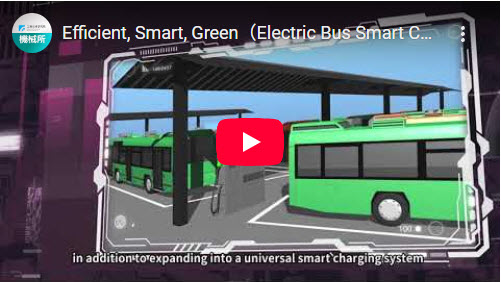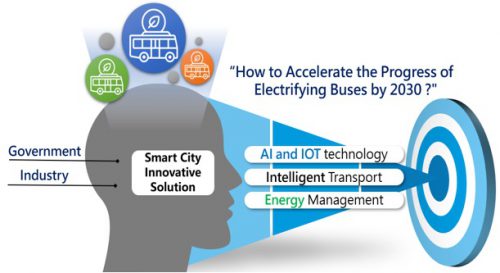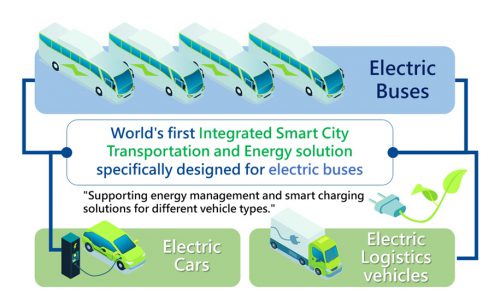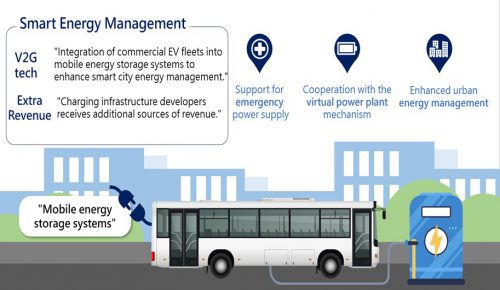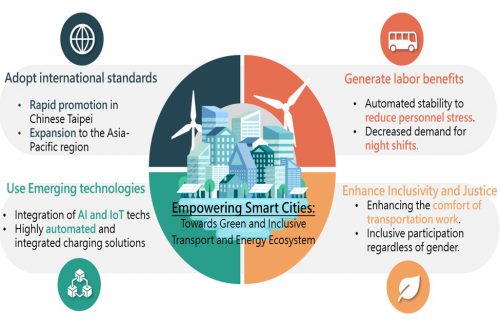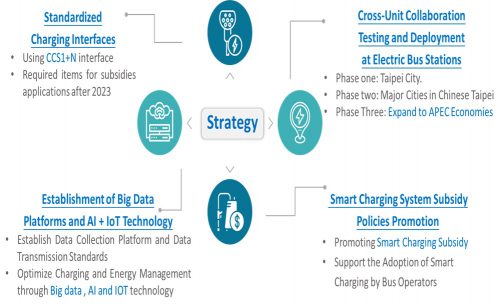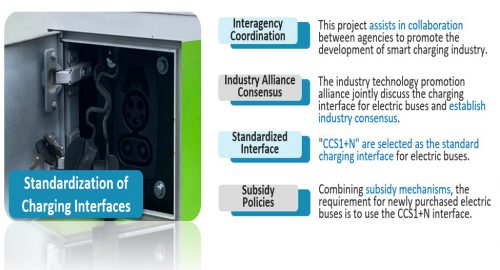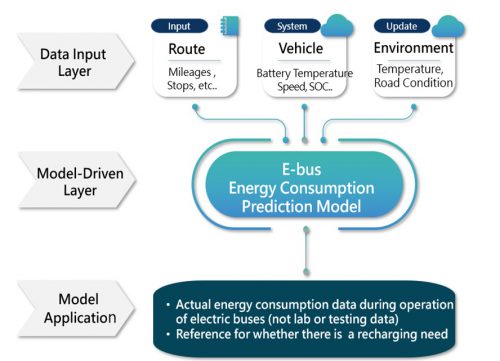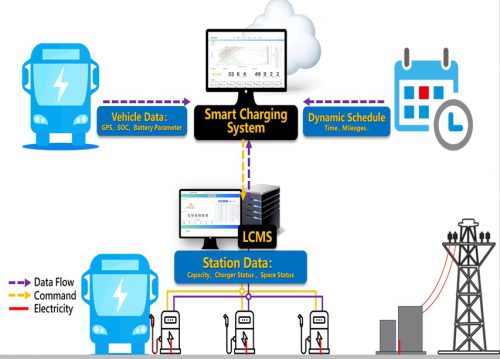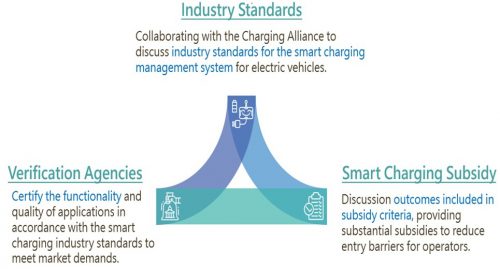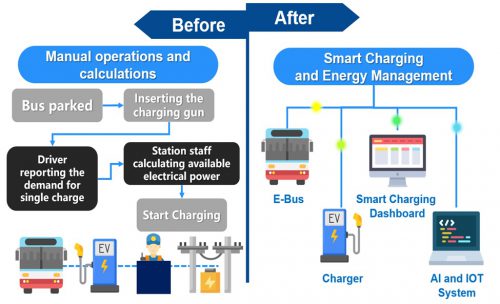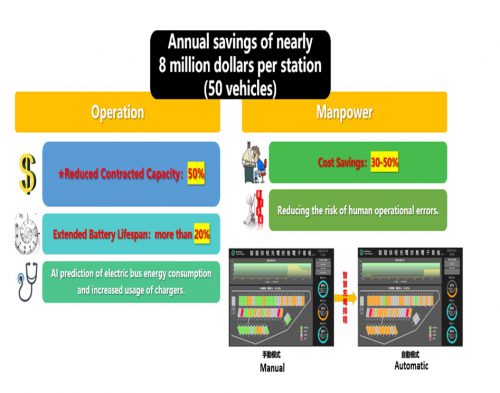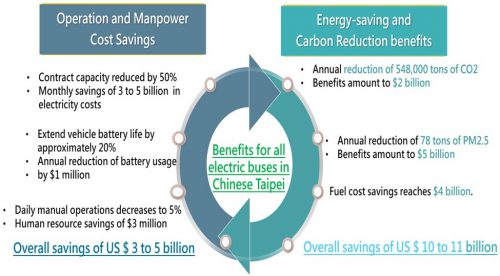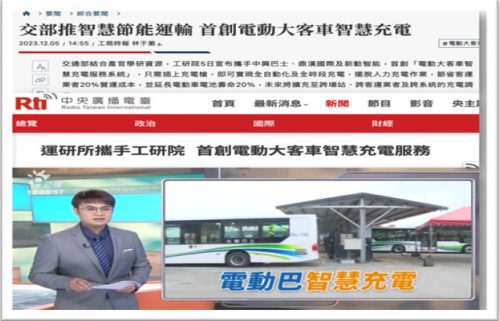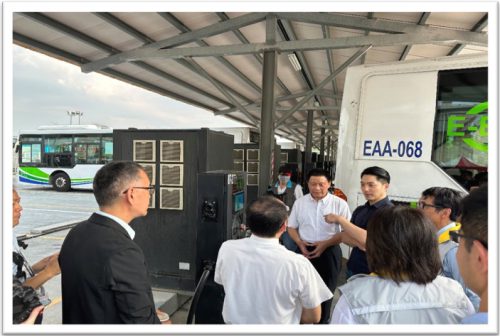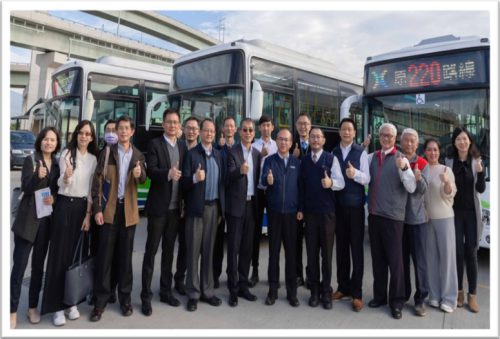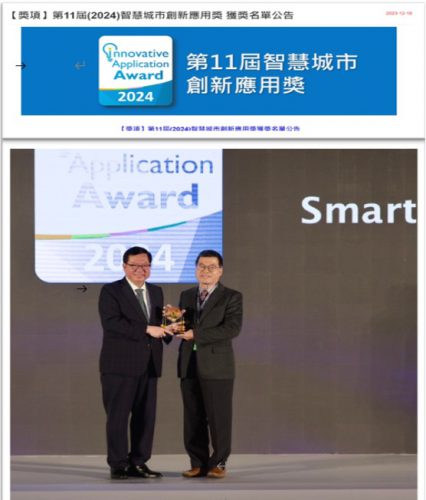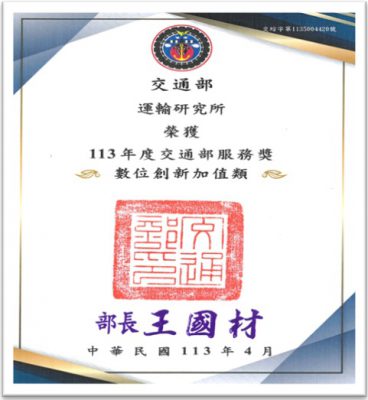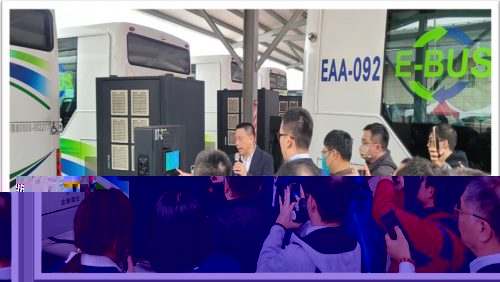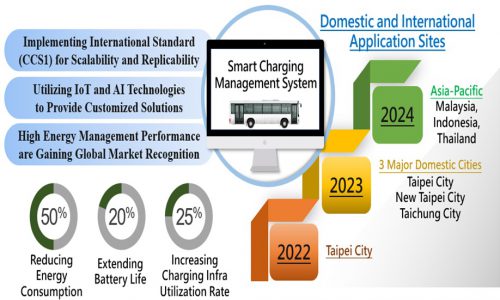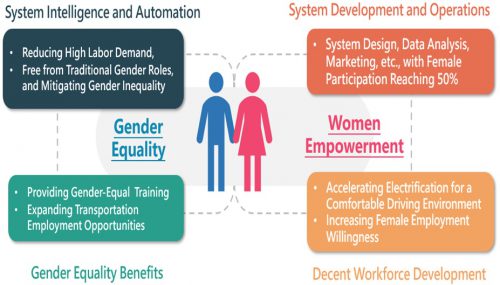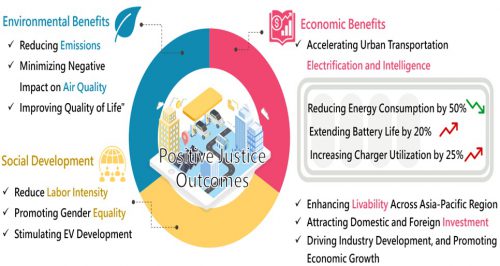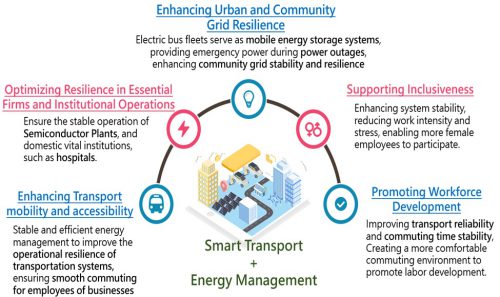Vision
 The 26th Conference of the Parties to the United Nations Framework Convention on Climate Change (UNFCCC COP26) has called upon all parties to adopt proactive climate action plans, aiming to halve global greenhouse gas emissions by 2030 and achieve net-zero by 2050. Currently, over 130 countries worldwide have presented declarations and action plans for “2050 net-zero emissions”. In addition , the Chairman’s Statement of the 2023 APEC Energy Ministers Meeting proposed that by 2035, around 70% of electricity generation in the APEC region’s power sector should come from carbon-neutral and carbon-neutral sources. Moreover, the APEC Transport Ministers Meeting held in 2023 also prioritized “mitigating the impacts of climate change” as one of its focus areas, highlighting the crucial role of the transportation sector in climate change adaptation. Therefore, the transportation sector plays a significant role in addressing climate change. In pursuit of transitioning towards net-zero emissions, many APEC members are actively promoting vehicle electrification. However, there are several pain points in the process, particularly concerning charging and energy management issues stemming from the widespread electrification of vehicles.
The 26th Conference of the Parties to the United Nations Framework Convention on Climate Change (UNFCCC COP26) has called upon all parties to adopt proactive climate action plans, aiming to halve global greenhouse gas emissions by 2030 and achieve net-zero by 2050. Currently, over 130 countries worldwide have presented declarations and action plans for “2050 net-zero emissions”. In addition , the Chairman’s Statement of the 2023 APEC Energy Ministers Meeting proposed that by 2035, around 70% of electricity generation in the APEC region’s power sector should come from carbon-neutral and carbon-neutral sources. Moreover, the APEC Transport Ministers Meeting held in 2023 also prioritized “mitigating the impacts of climate change” as one of its focus areas, highlighting the crucial role of the transportation sector in climate change adaptation. Therefore, the transportation sector plays a significant role in addressing climate change. In pursuit of transitioning towards net-zero emissions, many APEC members are actively promoting vehicle electrification. However, there are several pain points in the process, particularly concerning charging and energy management issues stemming from the widespread electrification of vehicles.
Based on the aforementioned visions of net zero development from international organizations including the United Nations and APEC, as well as the policy guideline of vehicle electrification in Chinese Taipei, in March 2022, Chinese Taipei announced “2050 Net Zero Emissions Pathway and Strategy”, presenting 12 key strategies. Among them, “Full Electrification of Buses by 2030” stands out as a crucial policy, marking a significant step towards achieving net zero emissions by 2050 for Chinese Taipei. However, as Chinese Taipei’s central and local governments, along with the electric bus industry, push forward with the implementation of this policy, we encounter challenges. With the large-scale increase in the number of electric buses and the simultaneous rapid charging, we face daunting issues in energy management, complex electricity grid supply and demand scheduling, and limited space for charging infrastructure. Addressing these multifaceted smart city energy management challenges urgently requires an effective, innovative, and climate-smart energy management solution for Chinese Taipei and even other economies in the Asia-Pacific region, as Figure 1 shows.
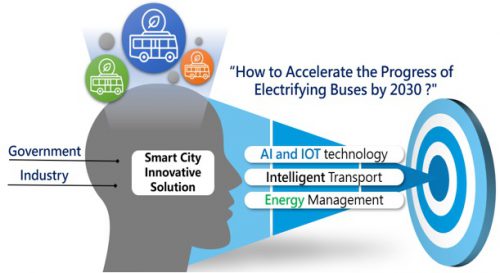
In response to the international trends of net-zero transition and digital transformation, the vision of this project aims to address the challenges mentioned above in vehicle electrification and energy management by integrating emerging AIoT technologies with smart transport system. We seek to develop innovative solutions for smart city transportation energy management, accelerating the pace of vehicle electrification in Chinese Taipei and the Asia-Pacific region. We are committed to build electrified vehicle energy management and charging integration services within smart cities. While there are already many charging systems internationally, they are mostly designed for charging passenger cars but cannot meet the simultaneous charging needs of large-scale bus fleets. Our vision is to create the world’s first intelligent charging management system specifically tailored for electric bus fleets, and to support smart city public charging solutions for different types of vehicles. This will simultaneously address the charging needs of electric buses, electric logistics vehicles, and electric passenger cars, significantly reducing the pain points of fleet operators and EV owners in electrification, enhancing the willingness to replace traditional fuel vehicles, and accelerating the ultimate goal of achieving net zero carbon emissions.
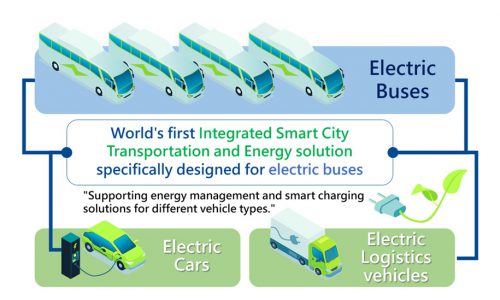
The smart transport solution and policy developed in this project not only supports charging services for different types of vehicles in smart cities (such as electric buses, electric logistics vehicles, and electric passenger cars) but also, through the application of V2G (Vehicle-to-Grid) technology, can treat electric commercial vehicle fleets such as electric buses as part of a “mobile energy storage system.” This system can provide emergency power supply for specific areas or critical infrastructure (such as hospitals) during temporary power outages caused by disasters. It can also cooperate with the virtual power plant mechanism of power companies to dynamically provide the stored energy on buses in parking lots, assisting the regional grid in providing stable power services and strengthening the resilience of urban and community power grid.
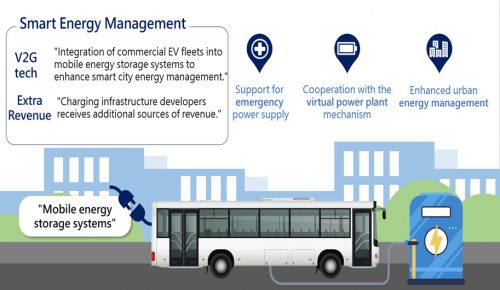
This project not only aims to achieve the vision of improving smart city energy management efficiency and achieving net-zero carbon emissions but also aims to create a standardized, automated, and inclusive ecosystem for smart transport and energy management. The project is committed to develop solutions with unified international standards, enabling rapid deployment not only in Chinese Taipei but also across the Asia-Pacific region to actively promote net-zero and digital transformation in smart cities. The project actively adopts emerging technologies such as AI and IoT to provide highly automated integrated charging solutions, further reducing the workload and night shift manpower of public transportation workers, and bringing benefits to the workforce development in the smart transport industry. Additionally, through the development of automated and intelligent energy management services, the project reduces labor intensity and enhances the comfort of transport work through facilitating the development of an automated and reliable electrified transport system, allowing both men and women to participate, serve, and contribute to this inclusive ecosystem of smart transport and energy management, promoting gender equality and social justice.
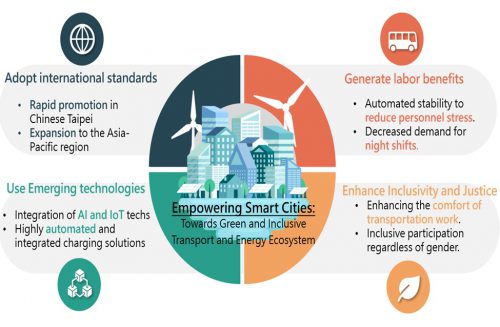
Stragety
Chinese Taipei is actively promoting the Electrification Plan for Buses by 2030. During this process, we have identified various difficulties and challenges faced by local governments and bus operators, such as land acquisition for parking, installation of charging stations, high-power electricity application, and battery efficiency issues, etc. To address these pain points, this project has developed and implemented strategies in four major areas: “Standardized Charging Interfaces,” “Establishment of Big Data Platforms and AIoT Technology,” “Cross-Unit Collaboration Testing and Deployment at Electric Bus Stations,” and ” Smart Charging System Subsidy Policies Promotion.” These initiatives aim to assist fleet operators in optimizing electric bus energy management, smart charging, and operational management, thus accelerating the promotion of bus electrification by 2030.
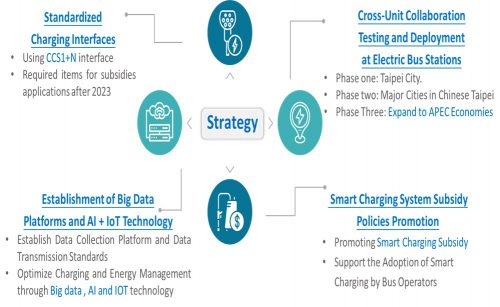
In the process of promoting the electrification policy for buses, we have found that one of the major obstacles for bus operators in purchasing electric buses is the challenges related to charging scheduling and energy management. Therefore,we actively coordinate the cross-domain communication and collaboration involving various stakeholders, including central and local governments, software industries, and bus industries, to address these issues.
Firstly, we established a cross-departmental coordination mechanism and collaborated with the Industrial Bureau and the Bureau of Standards of the Ministry of Economic Affairs, as well as the charging industry alliance , to promote the standardization of charging interfaces (CCS1+N). This facilitates the application and promotion of this project in Chinese Taipei.
Additionally, we developed an electric bus operation data monitoring and management platform and established data transmission mechanisms. We defined standard data collection items, transmission formats, and mechanisms to enable automated and digital data collection. Developing smart charging system through big data analysis ,cloud computing, and AI technology can enhance smart charging management.
Furthermore, to demonstrate the feasibility and practical benefits of our solution and technology, we collaborated with domestic smart transport industry and bus companies to implement the smart charging management system of this project at electric bus stations for operational management verification.
In the first phase, the smart transport solution was implemented in practice at the biggest electric bus charging stations so far in Chinese Taipei , equipped with chargers complying with international standards (CCS1) at 120kWh per charger. Through actual operations by several major bus companies in Taipei City and comparative analysis conducted before and after implementation, the system has demonstrated tangible application benefits over the course of operation.
Building upon the successful results from the implementation in Taipei City , the project has expanded further in the second phase. It now includes the three major metropolitan areas in Chinese Taipei: Taipei City, Taichung City, and New Taipei City. This expansion involves multiple bus companies, incorporating numerous electric bus fleets and charging facilities, including both private and public charging stations (as part of collaboration between Taipei City Government, Taipei Metro Company, and other regional bus companies ). The system is being further extended to effectively handle charging scheduling and energy management of shared electric vehicle charging stations for small vehicles, electric logistics vehicles, and electric buses.
Moreover, to accelerate the deployment and adoption of the smart charging solution developed by this project, Chinese Taipei has developed policies for bus electrification to offer subsidies to support the implementation of the smart charging system. This policy support encourages bus companies to adopt smart charging, thereby increasing the utilization rates of charging station , ensuring public transportation reliability and quality, and alleviating the burden on the power grid.
Measure
The four strategies and related measures developed by this project, namely, “Standardized Charging Interfaces,” “Establishment of Big Data Platforms and AIoT Technology,” “Cross-Unit Collaboration Testing and Deployment at Electric Bus Stations,” and “Promotion of Smart Charging System Subsidy Policies,” have all been effectively implemented. Below is an explanation of the execution process and results of each strategy.
1.Standardized Charging Interfaces:
Since 2021, we have collaborated with the Industrial Bureau and the Bureau of Standards, of the Ministry of Economic Affairs to accelerate the development of a favorable environment and conditions for the smart charging industry in Chinese Taipei. We have urged the Industrial Technology Research Institute (ITRI) to work with nearly 50 companies to establish the Electric Vehicle Energy Supply Industry Technology Promotion Alliance. After joint discussions, the alliance decided to standardize the charging interface for electric buses. It adopted the international standard “CCS1,” which is commonly used in Europe and the United States and supports direct current (DC) charging. Through the unified interface of private and public charging stations, we aim to create a friendly charging environment for promoting electric buses domestically and to accelerate the development of smart transport in Chinese Taipei. Additionally, we have completed the standardization of charging interfaces (CCS1+N) and adopted by the Ministry of Transportation and Communications'(MOTC) subsidy mechanism for electric buses. It is now a requirement for newly purchased electric buses eligible for subsidies to adopt the CCS1+N interface.
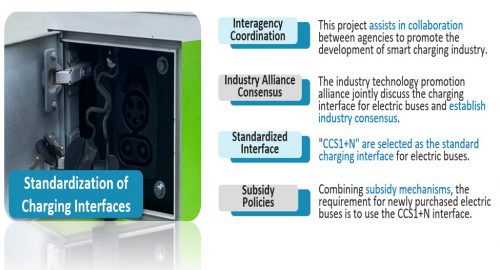
2. Establishment of Big Data Platforms and AIoT Technology
We began developing a large-scale Electric Bus Operation Data Monitoring and Management Platform as early as 2019-2020 and established data transmission mechanism to ensure the smoothness of the data collection required for the development of smart charging solutions. Through these specifications, we ensure the accuracy, consistency, completeness, and stability of big data collection for electric buses. Since 2021, the platform has been collecting operational data for electric buses, including vehicle and battery information, including charging infrastructure data and operational basics. This data is utilized to understand operational key performance indicators and critical issues, serve as a basis for annual vehicle performance evaluations, continuously review electric bus promotion policies, and form a crucial foundation for developing smart charging solutions for electric buses.
Utilizing the vast amount of data collected by the platform, the project has developed data analysis and AI-based models for electric bus operations. By employing AI technology and integrating platform data with other cross-domain data such as bus route characteristics, road traffic patterns, and weather conditions, we have established predictive models for electric bus operation and energy consumption. These models enable station dispatch personnel to monitor the remaining state of charge (SOC) of electric buses returning to the station in real-time, provide estimated energy consumption values based on departure schedules, and offer suggested charging amounts and timings, thereby significantly enhancing the precision of smart charging strategies and the operational efficiency.
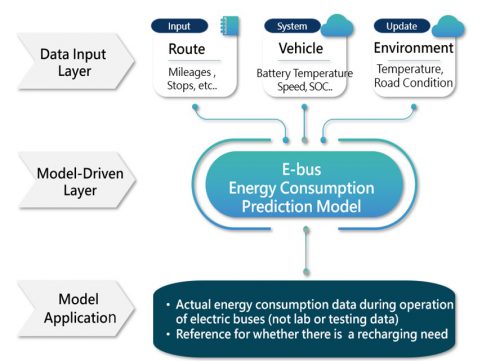
3. Cross-Unit Collaboration Testing and Deployment at Electric Bus Stations
Starting in 2021, we collaborated with government agencies, research institutions, charging equipment manufacturers, system integration service providers, and electric bus companies to conduct a real-world validation of the smart charging system at electric bus stations.
This smart transport solution utilizes interconnected Internet of Things (IoT) information from various systems and constructs a cloud-based platform. It integrates real-time driving data for electric vehicles (including license plate information, GPS data, state of charge (SOC), and battery temperature), dynamic fleet schedules (including license plates, routes, and rest times), and charging station data (including charger status, power, and contracted capacity). It analyzes the remaining battery levels for all vehicles, their departure order, and the power demand for each trip, taking into account various constraints such as daytime, nighttime, peak, and off-peak periods reflecting different price for electric power. It then automatically calculates the optimal charging power and schedules, satisfying the charging needs of fleet operation and scheduling.
Furthermore, multiple AI technologies are incorporated. The system utilizes long-term accumulated data and incorporates the AI energy consumption model. This model continuously updates in real-time with rolling data and predicts energy consumption values under different traffic battery conditions and ever environment and weather conditions. It automatically issues charging commands based on these predictions, optimally arranging charging power according to battery characteristics, and tracking battery health throughout its lifecycle based on accumulated charge and discharge records. This development aims to create a comprehensive and fully automated smart charging solution.
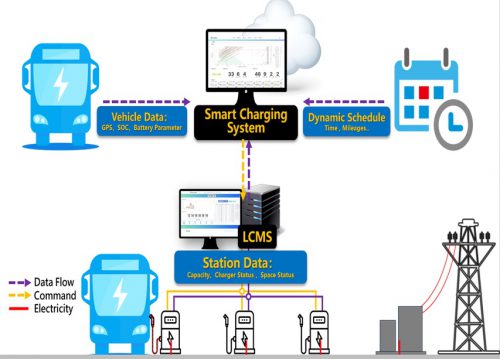
4. Smart Charging System Subsidy Policies Promotion
In addition to establishing standardized charging interfaces, operational data transmission mechanisms, and system validation processes, we continue to collaborate with the Charging Industry Alliance to engage in industry standard study for electric vehicle smart charging systems. This collaboration aims to assist fleet operators in adopting suitable smart charging and AI technology applications based on their needs and infrastructure conditions. Furthermore, it involves establishing verification units to ensure that the functionalities and quality meet market demands and subsidy requirements . The relevant research and development outcomes are incorporated into the MOTC’s subsidy guidelines for electric buses. These guidelines require bus companies to integrate smart charging at their charging stations. This aims to promote the successful experiences of smart charging solution adopted in Chinese Taipei and accelerate the deployment of the efficient, smart and green solution for electric bus charging and energy management.
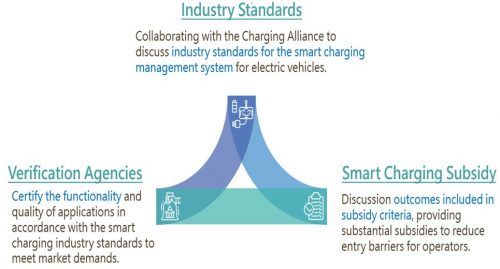
Performance
The strategies of this project have been successfully implemented, and the project performances and benefits are outlined as follows:
1.Benefits of the project at Chinese Taipei’s biggest electric bus station
Under the original charging operation modal of bus companies, drivers need to plug in the charging gun upon arrival at the station. They would then report the the procedure to the station operator, who manually calculates whether the remaining contracted capacity is sufficient and issues the charging command. During nighttime operations, station operators always struggle with the charging process. The manual charging decision-making process is cumbersome, and easily cause human errors in setting the charging power often result in fines for exceeding contracted capacity, as well as potential reduction in battery lifespan.
With the smart transport solution developed by this project, the charging procedure is automated. The system calculates the charging power required based on the remaining battery level, departure order, and trip mileage demands of vehicles. It then issues charging commands accordingly. After implementing the smart transport solution at Chinese Taipei’s biggest electric bus station, the project yields the following quantitative benefits:
(1) Significant Saving in Manpower Costs
Based on the project’s verification results, the implementation of smart transport solution can achieve over 30% cost savings in manpower especially during nighttime charging. Considering the anticipated significant increase in the number of electric buses and chargers in the future, the complexity and intensity of daytime scheduling and dispatching will significantly increase. Without the smart charging management system, a considerable amount of manpower would be required for charging scheduling and shift scheduling, and energy-saving charging may not be effectively executed. Therefore, with the implementation of this smart transport solution, if charging is conducted during the daytime, it could save over 30-50% in manpower costs, enhancing the competitiveness of fleet operators.
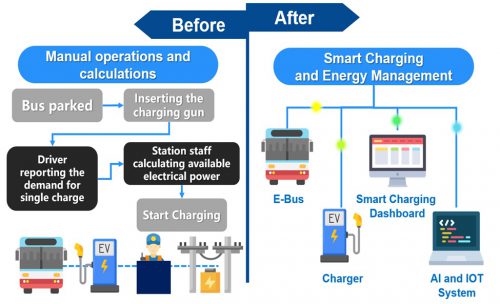
(2)Battery Life Extension
The project has proven to extend battery life more than 20%. Additionally, through long-term monitoring, anomalies in battery performance can be detected, and regular monitoring reports are provided to operators. This facilitates the early detection of battery aging and reducing failure risks, allowing for the provision of different charging modes according to the battery condition.
(3)Contracted Capacity Reduction
Currently, most electric buses primarily charge during nighttime. By implementing the system developed in this project, allowing charging of electric buses during the daytime can significantly reduce the costs associated with charging them all at the same time. As a result, the contracted capacity is expected to be reduced by around 50%, leading to substantial reductions in operational costs for bus companies.
(4)Increasing the Utilization and Efficiency of Charging Equipment
Based on the implementation results of this project, the ratio of vehicles to chargers was originally 54:54 (1:1). Through the enhanced smart scheduling introduced in this project, the ratio become 74:54. Subsequently, with the implementation of daytime scheduling to distribute the demand for charger usage, the ratio can increase to 2-3:1 or more, and the cost of stations can save over 20%.
(5)Reduction in Total Charging Time (Improvement in Operational Efficiency)
Derived from the benefits outlined above, there can be significant savings in total charging time for electric buses. During normal daytime operations, the implementation of this project’s system allows for charging scheduling and calculations based on factors such as the next departure time, the required amount of power charge for the next trip, and the charging needs of other electric buses. This enables efficient charging of electric buses, maximizing the utilization rate of chargers. Consequently, with the improved charging schedule and efficiency during daytime, the total operational time and mileage of electric buses can be increased, thereby enhancing bus companies operational profits.
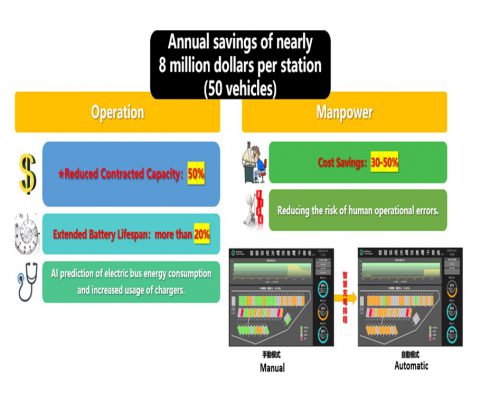
2.Benefits for all Electric Buses in Chinese Taipei:
Gradually expanding to all electric bus stations in Chinese Taipei to meet the charging needs of approximately 12,000 city buses, with a total contracted electricity demand of about 250,000 kilowatts; This smart transport solution is extended to support all bus stations in Chinese Taipei, the anticipated quantifiable benefits are estimated to reduce the monthly contracted electricity costs by approximately 0.1 to 0.2 billion US dollars, increase the battery durability, reducing battery usage costs by around 1.5 to 2 billion US dollars every year, and considering the personnel savings at bus stations of about 0.3 billion US dollars, resulting in an overall savings up to 3 to 4 billion US dollars every year.
The smart transport solution developed by this project is accelerating the electrification policy for city bus in Chinese Taipei by 2030, replacing diesel buses by electric buses is estimated to reduce CO2 emissions by 548,000 tons and PM2.5 emissions by 78 tons annually; monetizing the reduction in emissions per unit of vehicle-kilometer, the benefits of reducing CO2 emissions amount to 2 billion US dollars, and the benefits of reducing air pollution (PM2.5) emissions amount to 5 billion US dollars per year. After the electrification of city buses, the fuel is replaced by electricity, resulting in savings in fuel costs, which amounts to 4 billion US dollars per year when monetized per unit of vehicle-kilometer.
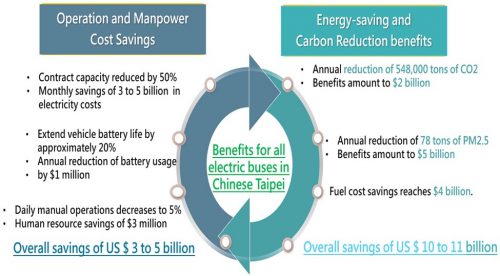
3.Media Coverage and Visits by Important Domestic Officials and Regional Economics
We have produced an international promotional video for this project.
After holding a showcase event of the project achievement on December 7, 2023, several print and television media, such as Radio International and Public Television, have reported on the outcomes of this project. Taipei City Mayor Wan-An Jiang and officials from the Transportation Bureau have visited the electric bus station implemented the smart transport solution and learn the successful results of the project in Taipei City and expressed their desire to expand the project’s experience to more locations in Taipei (The Taipei City Government has demanded Taipei Metro Corporation’s metro depot to utilize available electricity to establish shared charging stations for city buses and passenger cars, and to adopt the smart charging and energy management solutions developed in this project.). Deputy Minister Yan-Bo Chen of the Ministry of Transportation and Communications, Chinese Taipei, along with Director General Lin from the Department of Public Transport and Supervision and Director General Chen from the Highway Bureau, also have visited the project’s bus charging stations to understand the outcomes of this project to formulate and develop relevant policies to support the expansion.
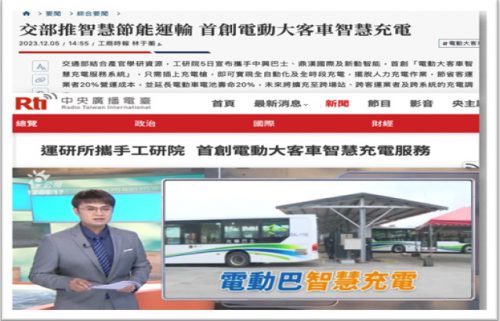
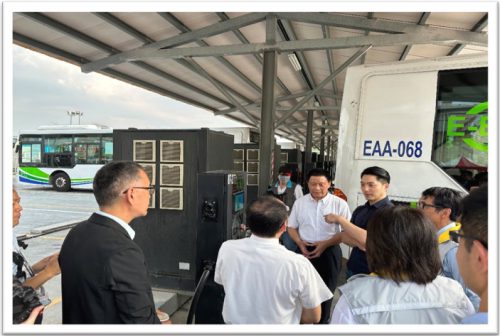
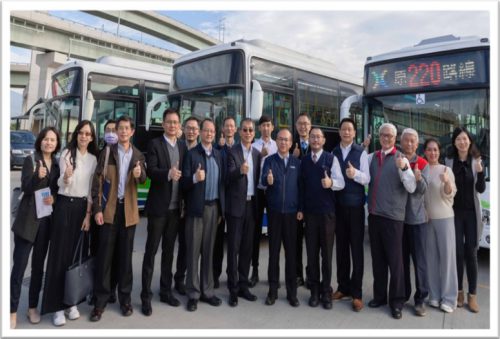
5.Recipient of the 2024 Smart City Innovation Award
The project won the 2024 Smart City Innovation Award for Smart Transport in Chinese Taipei. In March 2024, Director General Lin Chi-Kuo of the Institute of Transportation, Ministry of Transportation and Communications represented the project to receive the award from Deputy Premier of Chinese Taipei at the 2024 Smart City Expo.
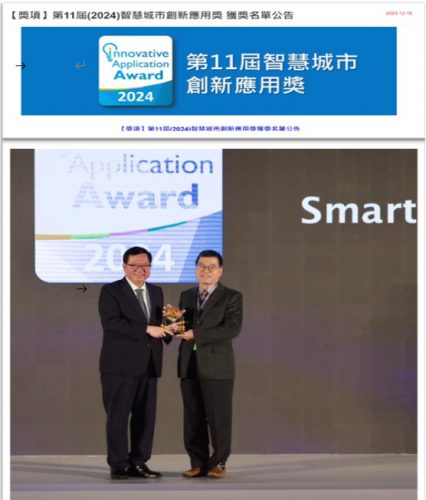

In addition to receive the Smart Transport Innovation Award in the 2024 Smart City Competition, the achievements of this project were also recognized with the 2024 Digital Innovation Service Award from the Ministry of Transportation and Communications of Chinese Taipei.
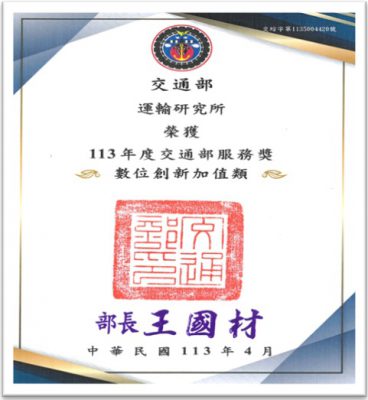
Internationalization
We have promoted the successful achievement of this project to governments and industry in Chinese Taipei, and the Asia-Pacific region through participation in various conferences and international exhibitions. In addition to being interviewed by several media and featured on television programs, the project will be presented at the APEC TPTWG 55th meeting to share concrete results with economies in the Asia-Pacific region. Furthermore, the project achievements will also be shared at the 2024 ITS World Congress.
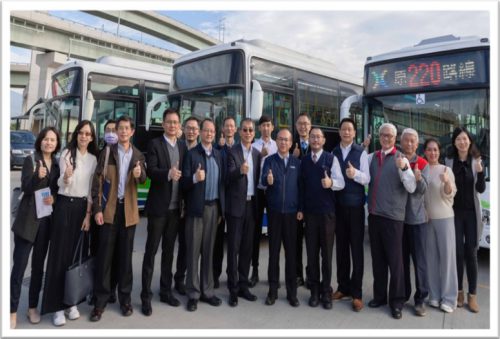
In terms of international deployment and expansion, the smart transport solution developed in this project adopts the international standard for charging (CCS1), which exhibits replicability and scalability for international applications. Currently, apart from several cities in Chinese Taipei (such as Taipei City, New Taipei City, and Taichung City), where multiple private and public electric vehicle charging stations are in use, many economies in the Asia-Pacific region, including Malaysia, Indonesia, and Thailand, are adopting this system in their public transportation services. By adopting the international standard for charging (CCS1), this project not only supports the goal of achieving city bus electrification by 2030 in Chinese Taipei, but also can offer highly customizable holistic solutions based on the characteristics of climate, traffic, and power environments in cities worldwide, leveraging IoT and AI technologies. This contributes to enhancing the willingness of economies to electrify large fleets and improve urban energy management efficiency, serving as a driving force for accelerating vehicle electrification in the APEC region.
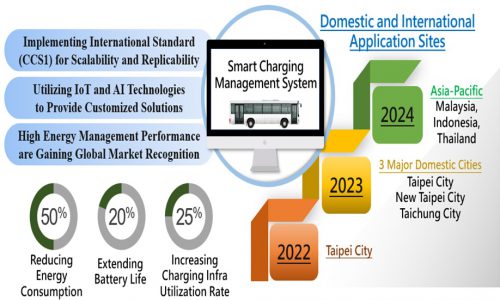
Inclusivity
We have successfully promoted and deployed the Electric Bus Smart Charging Management System developed in this project, thereby achieving various benefits, including inclusivity and gender equality, fairness and justice, social resilience, and job creation.
In terms of Women Empowerment, this project empowers women in various aspects such as technical development, system operation, and related training.
Firstly, women account for 50% of the participation in the development and operation of this system, engaging in different levels of operational and managerial work, including system design, data analysis, and marketing promotion, thereby cultivating their professional capabilities in the field of technology. Secondly, in the use and management of electric bus systems, this project helps accelerate public transportation electrification, making the driving environment more comfortable and reducing noise and stress in the workplace, thereby increasing the willingness and attractiveness of women and aging workers to employment in public transportation.
In terms of Equality, the intelligent and automated features of the system developed in this project reduce the demand for labor-intensive and physically intensive work, making the operation and management of electric buses more reliable. This successfully reduces the pressure of errors and the necessity of night shifts for drivers and station staffs, freeing them from traditional gender role constraints in operating electrified transportation tools. This further expands opportunities for women and aging workers participation in smart transport fields, thereby reducing gender and age discrimination and inequality in labor-intensive transportation work.
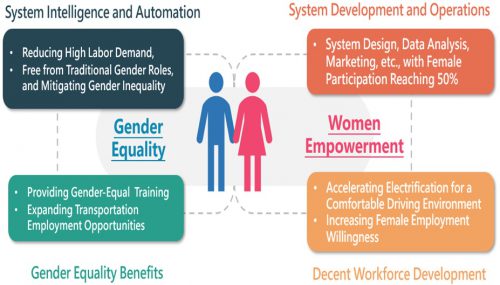
Overall, this project effectively enhances gender equality through skills training and expands employment opportunities. In addition to promoting positive impacts on energy management and smart transport , it empowers women, ensuring that both women and men can benefit from this project.
In terms of Justice, the smart charging solution developed in this project can also enhance fairness and deliver positive outcomes across various dimensions, including environmental, social, and economic aspects. Firstly, from an environmental perspective, this project aligns with global net-zero emission initiatives. By accelerating the electrification transformation of public transportation systems through intelligent infrastructure management, we not only aim to reduce greenhouse gas emissions but also significantly mitigate the negative impact of urban traffic on air quality. This improvement enhances the quality of life for urban residents while safeguarding environmental ecosystems.
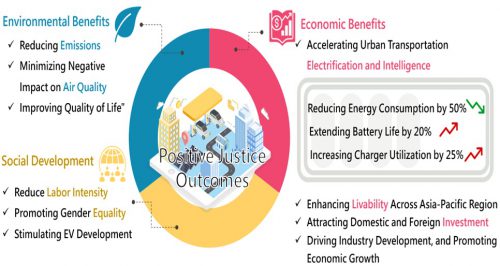
On the social front, this project supports gender equality and labor force development. The automation features of the smart charging system reduce labor intensity and optimize the comfort of public transportation drivers, enabling more female employees to participate in this field and promoting inclusivity in the workforce environment. Additionally, the promotion of this system will stimulate the development of the electric vehicle-related industry, creating more job opportunities and enhancing the quality of life for individuals.
Economically, this project has successfully developed a smart city vehicle charging solution, which can accelerate the electrification and modernization of public transportation in Chinese Taipei and other economies in the Asia-Pacific region. This will enhance the livability of cities in the Asia-Pacific region, attract more domestic and international investments, drive the development of EV-related industries, and promote economic growth. Moreover, by accelerating the electrification of vehicles, this project reduces reliance on traditional fuel sources, leading to energy cost savings. The project has successfully demonstrated its ability to assist electric fleet operators in reducing energy consumption by 50%, extending battery life by 20%, and increasing charging station utilization by over 25%, resulting in multifaceted economic benefits.
Overall, this project effectively achieves the equitable benefits defined domestically in Chinese Taipei, pursuing positive outcomes in environmental, social, and economic aspects, making valuable contributions to achieving various sustainability goals.
In terms of Social Inclusiveness and Resiliency development, this project represents not only a technical solution but also an endeavor towards highly resilient firms, institutions, communities, and smart cities. Our smart charging management system not only provides a more stable and efficient energy management model for public transportation systems but also enhances the operational resilience of urban electric transport systems. This ensures smooth commuting for employees of enterprises and institutions, while also improving the transportation mobility of smart cities and the accessibility of local communities. Furthermore, the application of this project’s system can strengthen the resilience of urban and community power supply. Electric buses and other commercial fleets can be viewed as mobile energy storage systems, providing emergency power supply during temporary blackouts caused by disaster events, ensuring the operation of critical industries (such as semiconductor plants) and essential domestic institutions (such as hospitals) in the Asia-Pacific region. Additionally, the system can support the virtual power plant mechanism of power companies, providing stable power services and enhancing the resilience of regional power grid. This helps alleviate the burden on the power grid, reduce the risk of power outages, and promote the electrical safety and livability resilience of communities.
Overall, this project transforms basic energy management facilities such as private and public charging stations, once considered undesirable facilities, into guardians of urban and community safety and resilience. Beyond meeting the charging needs of various smart transport systems and ensuring the stability of the power grid, it also ensures that urban residents, enterprises, and institutions can operate normally under various climate, environmental, and natural (such as earthquakes) impacts and pressures, actively adapting and transitioning towards sustainable development.
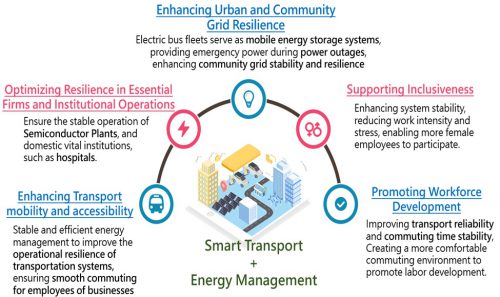
In supporting Decent Work and Workforce Development, the automation features of this system significantly reduce the need for manual operation and enhance the stability of electrified transportation systems in smart cities, reducing the intensity and pressure of work and creating a more decent working environment. This enables both male and female employees to participate more easily in the development of smart and electrified public transportation, whether in the operation of electric fleets or in the monitoring and maintenance of the system. Compared to traditional non-automated charging management models, this level of system intelligence and automation provides women with more comfortable employment opportunities and career development. Accelerating the electrification of urban vehicles through this project can improve urban air quality compared to traditional diesel buses, creating safer and more comfortable commuting environments for workers, reducing the discomfort of long commutes on diesel buses for urban and suburban residents. Moreover, the effective and smart transport energy management can also enhance the reliability of peak commuting times, further enhancing workforce development.
Criteria of 2024 ESCI and Key Explanations on Fulfillment (Please see the attached file: Criteria of 2024 ESCI and Key Explanations on Fulfillment.odt)
